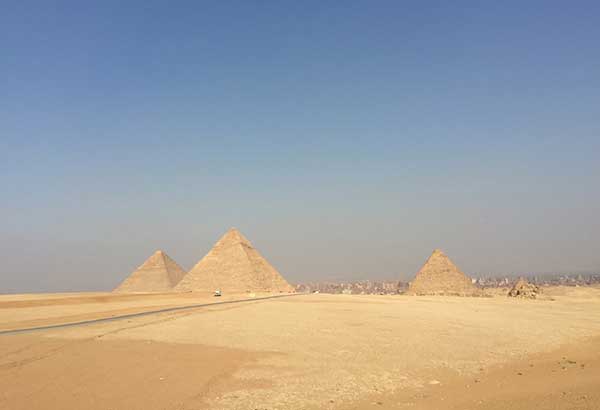Falling in love with Egypt’s 5,000 years of civilization


The Pyramids of Giza, testaments to an ancient civilization that is Egypt. Photos by Bum Tenorio Jr.
Ancient Egypt is super-advanced. Before visiting its pyramids, I fell in love with 5,000 years of civilization. While other populations were still in the stone ages, the Egyptians, it seems, were born modern.
The people of ancient Egypt were way ahead of their time. They were civilized, possessing early knowledge of architecture, medicine, gynecology, ophthalmology, social etiquette, engineering and more.
There are more than 100 existing pyramids in Egypt but the Pyramids of Giza are the most outstanding and astounding works of architecture and engineering. The construction of these pyramids some 5,000 years ago was so mindboggling that, I read somewhere, they could have been built by aliens. (Of course not… right?)
I always wondered what it was like inside the early pyramids. Were there mummies, treasure chests inside? So I was quite excited to finally explore my childhood curiosities when Royal Way Tours in Egypt (represented in the Philippines by the indefatigable Ching Nejal) allowed me to tick Egypt off my bucket list. Before going to Egypt, my BFF Bum Tenorio and I checked the weather and found out it was very hot — the temperature was between 38 degrees and 52 degrees — so we prepared ourselves mentally and physically for this big adventure. (We were told the best time to visit Egypt is between November and February.)
We boarded Etihad, which was very comfortable and cozy for our evening flight. Before we went to sleep on the plane, Bum and I exchanged notes on what we knew about the Great Pyramids of Egypt. We imagined coming up close and personal to the mammoth tombs, even seeing Cleopatra in our mind’s eye dancing in her golden garments.
When we woke up, we were in Cairo. Together with the members of our rambunctious and loving group, we could see the pyramids in the distance just outside the busy city. Egypt was searing when we arrived but the thought of seeing the pyramids of Giza — the only existing of the Seven Wonders of the Ancient World — was more than inviting. Well-hydrated and well-covered for the heat, we toured neighboring cities of Cairo and Giza. Since it was Sunday when we arrived, we heard a Mass first officiated by the priest with us in the group, Fr. Bernabe dela Cruz, in a private chapel under the care of nuns. Yes, in a Muslim country like Egypt, freedom to celebrate one’s faith is tolerated. Out of the 95 million population of Egypt, according to our highly knowledgeable tour guide Shereen Tousson, 10 percent are Christians.
The knowledge we had of the Egyptian pyramids seemed Lilliputian when we came face to face with the actual Giza pyramids, the most substantial and mysterious ancient structures in the world. Shereen mentioned to us that the three pyramids on the Giza plateau are funerary structures of three kings of the fourth dynasty (2575 to 2465 B.C.). The Great Pyramid is attributed to Khufu (Cheops); next to it is the pyramid attributed to Khafra (Chephren); and the smallest of the three is that of Menkaura (Mycerinus).
“The Great Pyramid was originally 481 feet, five inches tall (146.7 meters) and measured 755 feet (230 meters) along its sides. Covering an area of 13 acres, or 53,000 square meters,” says Shereen. The Great Pyramid is reportedly large enough to contain the European cathedrals of Florence, Milan, St. Peters, Westminster Abbey and St. Paul’s. Constructed from approximately 2.5 million limestone blocks weighing an average 2.6 tons each, its total mass is more than 6.3 million tons (representing more building material than is to be found in all the churches and cathedrals built in England since the time of Christ).
Bum (childlike in his awe and wonder as he also traveled to Egypt with the Doraemon toy entrusted to him by his dear friend Rodge Valientes) and I found a pathway leading to the top of The Great Pyramid and started our ascent. We could hear Shereen in her sweet voice explaining that The Great Pyramid was originally encased in highly polished, smooth white limestone and capped, according to legend, by a perfect pyramid of black stone, probably onyx.
As to where the sandstones were gathered to build the pyramids of Giza — it was a mystery in the beginning, until a record showed that they were hauled from Luxor, located 500 miles south of Giza. Later on it was found out that the Nile played an important role in shipping the giant blocks of stone upriver. (More on Luxor and other ancient temples in Egypt and our Nile River cruise in my next articles.)
After the pyramids, we had a close encounter with the famous Sphinx, which is undoubtedly the greatest monumental sculpture of the ancient world. The Sphinx, though bearing traces of erosion, is still majestic with its structure bearing a pharaoh’s head with a body of a lion.
“Giza is much older than Cairo. It goes back to ancient Egyptian times, and the Giza pyramids are its existing antiquities dating back to 26th century B.C.,” emphasizes Shereen.
“Cairo was founded in the 10th century A.D. It is the largest capital city in Africa and the third populated capital city in the world. It used to be known as the city of One Thousand Minarets during medieval times. Many mosques were built in the city starting 7th century AD,” adds Shereen.
Cairo today is considered a cosmopolitan city with many beautiful palaces, public parks, cinemas, theaters and an opera house. It houses several museums but the most celebrated is the Egyptian Museum.
The Museum of Egyptian Antiquities, known commonly as the Egyptian Museum in Cairo, is home to the most extensive collection of ancient Egyptian antiquities in the world. It has 120,000 items, with a representative amount on display, the remainder in storerooms and parking lots.
If you’re looking for mummies and their sarcophagi, you don’t have to look very far because when you enter the museum, they welcome you at the first-floor entrance. And wait till you see the museum’s Royal Mummy Room. Eerie? Not really, if you will listen to the stories that lie inside the many sarcophagi and tombs inside the museum.
The Egyptian Museum of Antiquities contains many important pieces of history. Not only does it house the world’s largest collection of pharaonic antiquities, it also houses the many treasures of King Tutankhamen and many interesting statues that moved with the museum’s many relocations.
The museum’s ground floor has an extensive collection of papyruses and coins used in the ancient world. The relics of papyrus are generally small fragments because they have decayed over several millennia. Visible still on the papyruses are writings in different languages including Greek, Latin, Arabic, and the ancient Egyptian writing language of hieroglyphs. The coins found on this floor are made of many different elements, including gold, silver and bronze. In ancient times, Shereen informed us, silver had more value than gold.
After visiting the Egyptian Museum in Cairo, we were mesmerized next by the sight of Saints Sergius and Bacchus Church, also known as Abu Serga, a Coptic Christian church. This church, dedicated to the saints Sergius and Bacchus, is most famous due to the belief that it was built on the site where Joseph, Mary and baby Jesus resided during their time in Egypt.
“Abu Serga was thought to have been built in the 4th or 5th century and is one of the oldest Coptic churches in Egypt. One of its most interesting features is the crypt where the Holy Family were said to have rested. The crypt is 10 meters deep and, when Nile levels are high, is often prone to flooding,” Shereen says.
There was a feeling of serenity when we beheld the dwelling area where Mary and Joseph were said to have cared for their child Jesus. Atop the dwelling place was an ancient well said to be where the Holy Family fetched their water.
In ages-old Cairo, the story of Jesus Christ is part of its “new” history. Despite the ultra-Muslim presence in the country, even the story of Christ is held in high esteem. The ancient history of Egypt is beguiling, even mind-boggling.
“Egypt is waiting. Thousands and thousands of years of civilization is here. Won’t you come? What else will inspire others to come see the ancient civilization of the world?” said Ashraf Sayed, owner and president of Royal Way Tours.
On our last day in Giza, we drove past the street that led to the Pyramids of Giza. The pyramids made their presence again albeit quickly. In my heart, I knew I was winking again at 5,000 years of civilization.
* * *
For inquires about tours to Cairo and Giza, call the Manila office of Royal Way Tours at 0919-4306630, 0915-8686895, 02-2634829.
Email the author at miladay.star@gamil.com.



















